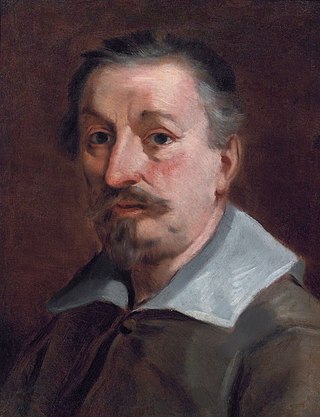
Francesco Albani or Albano was an Italian Baroque painter who was active in Bologna (1591–1600), Rome (1600–1609), Bologna (1609), Viterbo (1609–1610), Bologna (1610), Rome (1610–1617), Bologna (1618–1660), Mantova (1621–1622), Roma (1623–1625) and Florence (1633).

The Basilica of San Petronio is a minor basilica and church of the Archdiocese of Bologna located in Bologna, Emilia Romagna, northern Italy. It dominates Piazza Maggiore. The basilica is dedicated to the patron saint of the city, Saint Petronius, who was the bishop of Bologna in the fifth century. Construction began in 1390 and its main facade has remained unfinished since. The building was transferred from the city to the diocese in 1929; the basilica was finally consecrated in 1954. It has been the seat of the relics of Bologna's patron saint only since 2000; until then they were preserved in the Santo Stefano church of Bologna.

Marcantonio Franceschini was an Italian painter of the Baroque period, active mostly in his native Bologna. He was the father and teacher of Giacomo Franceschini.

The Palazzo Colonna is a palatial block of buildings in central Rome, Italy, at the base of the Quirinal Hill, and adjacent to the church of Santi Apostoli. It is built in part over the ruins of an old Roman serapeum, and it has belonged to the prominent Colonna family for over twenty generations.
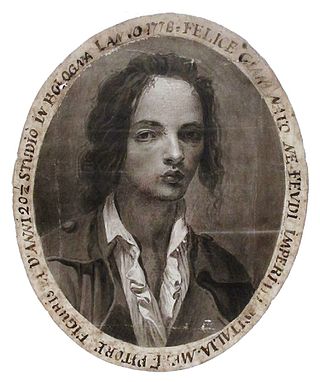
Felice Giani was an Italian painter of the Neoclassic style. His grand manner subjects often included Greco-Roman allusions or themes.

Pelagio Palagi was an Italian painter, sculptor and interior decorator.

San Procolo is an early Gothic-style, Roman Catholic church and former monastery-hospital located on Via Massimo D'Azeglio #52 in central Bologna, region of Emilia Romagna, Italy.
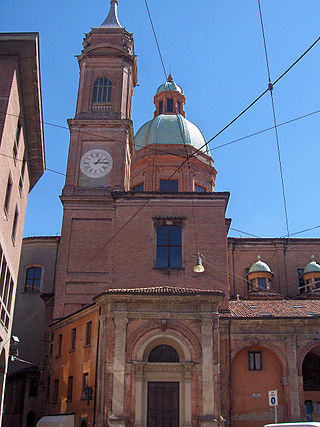
Santi Bartolomeo e Gaetano is a Renaissance style, Roman Catholic church in central Bologna; it is located near the Two Towers, adjacent to the Strada Maggiore.

The Palazzo Poggi is a palazzo in Via Zamboni 33, Bologna, Italy. It is the headquarters of the University of Bologna and of the rector of the university.

The Palazzo Pepoli Campogrande, also known as Palazzo Pepoli Nuovo, is a Baroque style palace on Via Castiglione 7 in central Bologna, region of Emilia-Romagna, Italy. In 2015, it served as a public art gallery for late-Baroque art. Across the Via, rises the medieval Palazzo Pepoli Vecchio, also once pertaining to the same family, which now serves as a museum of the history of Bologna.

The Sanctuary of Santa Maria della Pioggia is a small church, located on Via Riva Reno 122, between Galliera road and Riva di Reno road in central Bologna, Italy. It was once the Oratory of San Bartolomeo di Reno.
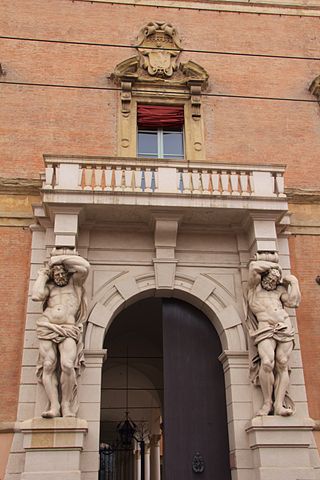
The PalazzoDavìaBargellini is a Baroque style palace located on Strada Maggiore in central Bologna, Italy. It presently hosts the Civic Museum of Industrial art and Davìa Bargellini Gallery, which is an eclectic collection of paintings as well as applied arts and functional ornamentation, described as curiosities of the old Bologna. The diverse applied art collection includes ceramics, liturgical robes, keys, ornamental door knobs, marionettes from street theaters, furniture, iron grille work, elaborately carved wooden frame, and a gilded carriage.

The Palazzo Orsini is a neoclassic-style palace located on via Borgonuovo #11 in Milan, region of Lombardy, Italy.
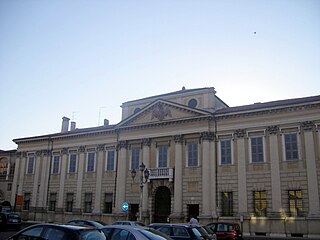
The Palazzo D'Arco is a Neoclassical-style palace located on Piazza Carlo D'Arco #4 in Mantua, region of Lombardy, Italy. The palace houses the Museo di Palazzo d'Arco, which displays the furnishings and artwork collected by the Duke D'Arco.

The Palazzo Zambeccari at 11 Via Carbonesi is a Neoclassical urban palace in central Bologna, region of Emilia-Romagna, Italy. It is located diagonal to the facade of San Paolo Maggiore, and in 2015 was home to offices of the Banco Popular di Milano SCRL.
The Palazzo Pallavicini is a sprawling 15th-century palace located on Via San Felice #24 in Bologna, region of Emilia Romagna, Italy. It extends to Via del Pratello and Via de'Coltellini. There is another Palazzo Pallavicini in Bologna located on Via San Stefano.

The Palazzo Malvezzi de' Medici is a Renaissance-style palace located on Via Zamboni #13 in central Bologna, Italy. The palace now houses the offices of the Provincial Administration.
The Palazzo Guadagni Strozzi Sacrati is a palace located between via dell’Oriuolo, via de’ Servi, and via Bufalini in central Florence, region of Tuscany, Italy.
The Palazzo Vizzani Lambertini Sanguinetti, sometimes known merely as Palazzo Vizzani, is a Renaissance palace located on Via Santo Stefano #43 in the center of Bologna, region of Emilia-Romagna, Italy. Presently the palace houses the faculty of Foreign Languages and Literature of the University of Bologna.
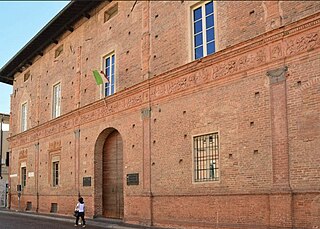
Palace Carminali Bottigella is a noble palace built by the ancient Beccaria family from Pavia. The original structure from the Sforza era was built between 1490 and 1499. The façade, which retains the original terracotta decorations, is one of the major examples of Renaissance civil building in Pavia.


















